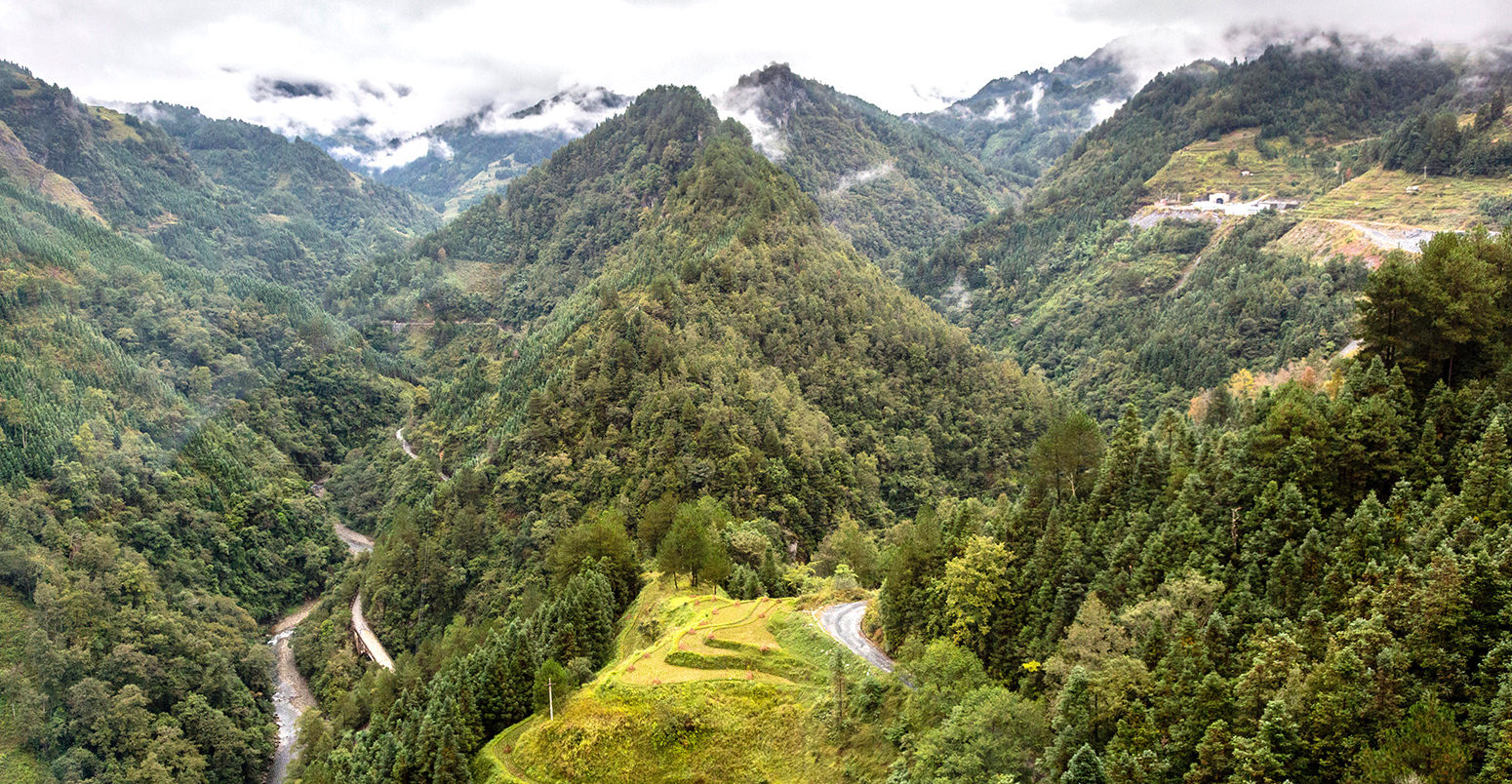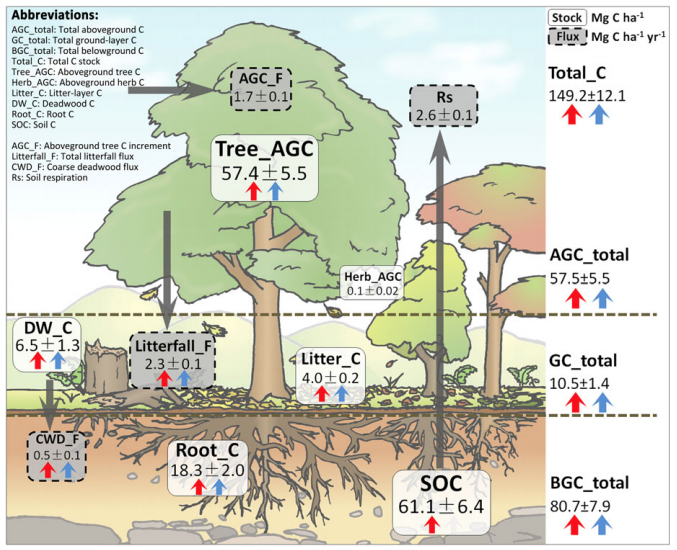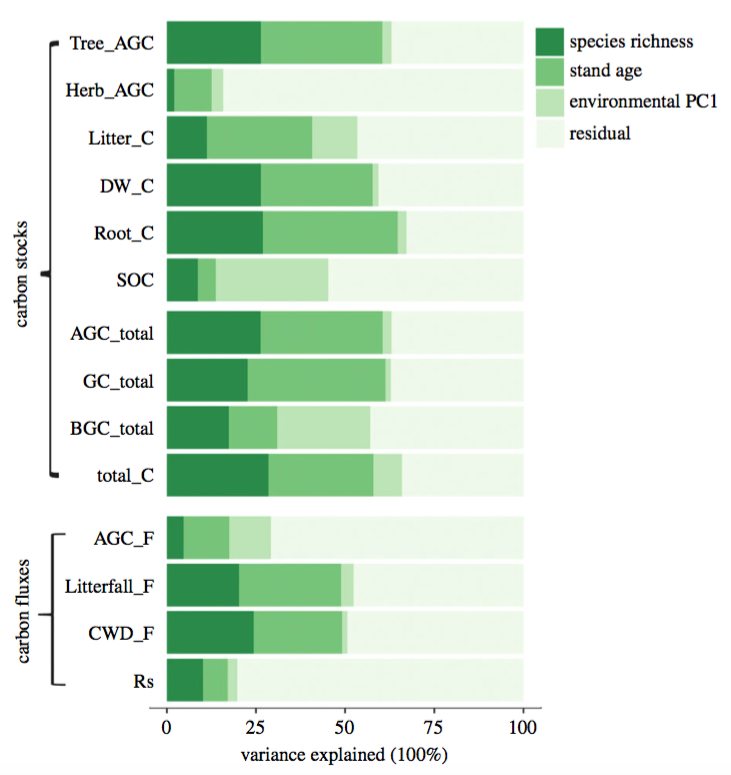
Planting a mix of tree species ‘could double’ forest carbon storage
Daisy Dunne
08.22.18Daisy Dunne
22.08.2018 | 12:01amForests containing several tree species could store twice as much carbon as the average monoculture plantation, research finds.
A study looking at the carbon storage of forests in southern China finds that each additional tree species introduced to a plantation could add 6% to its total carbon stocks.
The findings suggest that afforestation programmes – which aim to plant trees to “suck” CO2 out of the atmosphere – should switch from using just one plant species to a more diverse mix, a study author tells Carbon Brief.
Planting a diverse range of trees could also bring many co-benefits, the author adds, including providing habitats for a larger range of animals.
However, the relatively small scale of the experiment may have led researchers to overestimate the relationship between tree species diversity and carbon storage, other scientists tell Carbon Brief.
Planting power
Limiting global warming to 1.5-2C above pre-industrial levels – which is the goal of the Paris Agreement – is likely to require the use of “negative emissions technologies” – methods that aim to reduce the impacts of climate change by removing CO2 from the air.
Increasingly, some scientists are arguing that “natural climate solutions”, such as “afforestation”, should take precedence in efforts to achieve negative emissions. Afforestation refers to the practice of planting new forests in areas that currently do not have trees.
During photosynthesis, trees absorb CO2 from the atmosphere, and later use it to build new materials – such as trunks, stems and roots. Because of this, forests are capable of absorbing CO2 from the air and storing it as carbon for long time periods. At present, forests store as much as 45% of all land carbon.
However, the total amount of CO2 that could be offset using afforestation remains uncertain. This is because there are still lots of unknowns – including which areas should be targeted for afforestation and which tree species would be the best to use.
The new study, published in the Proceedings of the Royal Society of London B, looks at one such question – how could the number of tree species present in a forest affect its ability to store carbon?
To find the answer, the researchers studied the carbon storage of several forests plots within the Gutianshan National Nature Reserve in southeast China. Each plot contained between three and 20 tree species.
The results show that the most diverse forests are “faster” at storing carbon, says study co-author Prof Bernhard Schmid, a plant biologist from the University of Zurich. He tells Carbon Brief:
“With increased species richness, more carbon is stored both above and below ground – in trunks, roots, deadwood, mould and soil. You can roughly say that a diverse forest stores twice the amount of carbon as the average monoculture.”
Charting trees
For the study, the researchers established 27 30-by-30-metre plots inside the nature reserve – each containing between three and 20 tree species.
From 2008-10, the researchers recorded changes to the amount of carbon stored by each forest plot. The researchers considered “above-ground carbon” – the carbon stored by trees, shrubs (or “herbs”), “ground carbon” – the carbon stored by leaf litter and dead wood and “below-ground carbon” – the carbon stored by plant roots and the soil.
To understand how carbon stocks had changed, the researchers measured changes to “biomass” – the weight amassed from the production of new leaves and shoots, or the thickening of a tree trunk, for example.
The diagram below shows the estimated average amount of carbon stored by different forest components, in terms of tonnes of carbon stored per hectare. The presence of a red arrow indicates that tree diversity has had a positive impact on that particular carbon stock, while a blue indicates that the age of the forest has had a positive impact.
On the diagram, grey boxes show the results for temporary exchanges of carbon – known as “carbon fluxes”, while white boxes show the results for long-term carbon stocks.

Diagram showing the average carbon stock (carbon stored per hectare) of different forest components, including trees (Tree_AGC), shrubs (Herb_AGC), deadwood (DW_C), leaf litter (Litterfall_C), roots (Root_C) and soil carbon (SOC). Grey boxes show the results for “carbon fluxes”, while white boxes show long-term carbon stocks. To the right, the total forest carbon stock (Total_C), above-ground carbon (AGC_total), ground carbon (GC_total) and below-ground ground (BGC_total) is indicated. A red arrow indicates that tree diversity has had a positive impact, while a blue indicates that forest age has had a positive impact. Source: Liu et al. (2018)
The results show that, the average amount of carbon stored across all the plots was 149 tonnes per hectare, with above-ground carbon contributing 56 tonnes per hectare, ground carbon contributing 11 tonnes per hectare and below-ground carbon contributing 81 tonnes per hectare.
For the next part of the study, the researchers used statistical methods to estimate how much of the variation in carbon storage between the plots could be “explained” by tree species diversity.
The chart below shows the proportion of the variation that could be explained by species diversity (dark green), forest age (medium green), environmental factors – such as elevation – (light green), and “residual” factors (greenish white), which are factors that are still unknown.

The proportion of variance in carbon stocks of the experimental plots that can be explained by species richness (dark green), forest age (medium green), environmental factors (light green) and residual effects (greenish white) for various forest components, including trees (Tree_AGC), shrubs (Herb_AGC), deadwood (DW_C), leaf litter (Litterfall_C), roots (Root_C) and soil carbon (SOC). Results are shown for the total carbon stock (total_C), above-ground carbon (AGC_total), ground carbon (GC_total) and below-ground carbon (BGC_total). The bottom half of the chart shows the results for short-term “carbon fluxes”. Source: Liu et al. (2018)
The results show that species diversity can explain around a quarter of the variation in total carbon storage of the different forest plots.
The age of a forest could explain a similar amount of the observed variation, the results show. This result is to be expected, the researchers say, as it is known that, as trees grow over time, they store larger amounts of carbon.
As with all biological studies, there remains a number of other factors involved that the researchers weren’t able to pin down, Schmid says:
“It is ‘residual’ because we don’t have a clue of what it could be. Residual variation is usually much larger for ecological studies than it is in our example. You can explain a lot, but there is always a large amount of unexplained information.”
Partnered plants
The researchers then compared their results to previous data on carbon storage from monoculture plantations in China. (In the past few decades, China has invested more in afforestation than any other country.)
The comparison showed that introducing additional tree species to monoculture plantations could greatly improve carbon storage, the researchers say in their paper:
“Overall, for each additional tree species, the total [carbon] stock increased by 6.4%.”
Most monoculture plantations in China tend to be made up of eucalyptus, bamboo or Japanese cedar trees. The new study does not explore what types of trees could be used alongside these plants, but does advocate that a mix of plant species is more likely to boost carbon stocks.
There are several reasons why tree species diversity could improve carbon storage, the researchers say. For example, different tree species occupy different heights and spaces in the canopy – meaning a diverse canopy is better able to capture incoming sunlight.
In addition, diverse forests attract a greater range of animals – many of which act as pollinators, aiding plant reproduction. A higher rate of pollination enables a forest to grow faster, and, thus, absorb CO2 more quickly, the researchers say.
Overall, the results suggest that afforestation programmes should “switch” from growing monoculture plantations to more diverse forests, says Schmid:
“Our recommendation is that afforestation programmes should switch from focusing on monocultures to mixtures. Until we know more about the contribution of each particular species, the best approach is simply to plant several species in mixtures. This will help both carbon storage and the preservation of biodiversity.”
The findings are “interesting” and suggest that including more than one tree species in afforestation programmes could boost carbon storage productivity, says Dr Charlotte Wheeler, a forests researcher from the University of Edinburgh, who was not involved in the research. She tells Carbon Brief:
“However, the main problem I see with it is it uses particularly small plots. Previous research shows that, over larger areas of land, the relationship between tree species diversity and productivity sort of levels off. The main reason for that is, over a small area, a diverse mix of trees make better use of resources – but this effect plateaus in larger areas, and other factors become more important.”
Agreeing with Wheeler, Dr Martin Sullivan, a tropical forests researcher from the University of Leeds, who was also not involved in the research, tells Carbon Brief:
“There is some evidence that diversity-carbon relationships are scale-dependent and the plots used here are quite small, so it is possible that relationships will be weaker, or absent, if larger plots were used.
“Also, I think all plots used in this study were recovering from past disturbance [deforestation] and a recent study found that diversity-carbon relationships were positive in disturbed forests, but absent in intact forests.”
Liu, X. et al. (2018) Tree species richness increases ecosystem carbon storage in subtropical forests, Proceedings of the Royal Society of London B, doi/10.1098/rspb.2018.1240
-
Planting a mix of tree species ‘could double’ forest carbon storage
-
Diverse forests store ‘twice as much carbon’ as plantations

